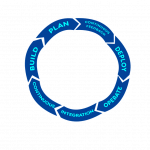eMark Consulting just completed a SharePoint implementation for a manufacturing client that included a large change management component. Through our assessment process, the change initiative was estimated as the highest critical success factor by the executives and steering committee. The project, which replaced its existing intranet portal with SharePoint 2010, was designed to structure corporate document management, provide a collaborative communication platform, and create new workflows to streamline business operations.
As we began working with the project team and stakeholders, it became obvious that the change initiative was not only critical to success, but also imperative to the long-term viability of the business. This shifted our focus from software implementation to the long-term business value of SharePoint as we mapped the core competencies of the company to the features of product. The output of this effort was a clearly defined map of the change components and a strategy for implementation.
SharePoint and change can be synonymous when working to drive and create value for your business. While, externally, change is a natural occurrence and force for any business, internally changes take time, communication and patience to be implemented successfully. The following were key points we used to effectively plan and control the SharePoint deployment for our client; I hope they will be useful for your business.
Educate: Deployment statistics have shown that 72% of projects implemented with specific emphasis on educating stakeholders and the user community throughout the project achieve success. When project team members are educated on SharePoint and how the product will positively affect their business long-term, adoption and change become better understood and the project overall becomes easier for the project manager to control.
Communicate: Those of you who have heard me speak at events and conferences know that I’m a huge proponent of communication and sharing information among work teams (at a project level) and throughout the business (at a corporate level). Sharing information about the project, timelines, and deliverables will create an expectation for business and end users throughout the organization.
When first communicating on change management, emphasis should be placed on the “low-hanging fruit” of the organization. What change will be the most impactful for the company? What is the fastest way to make that change so people can see the benefits of SharePoint early on in the project? Once the change has been identified, communicate it so that the business can see the success and changes with their own eyes.
Use the Tool: We always recommend that implementation teams create a sandbox for their own use during the project. The sandbox can be used for a multitude of things: from communicating through team sites to sharing project plans among the team. On a change management project, use the tool to test functionality and, once proven, invite end users to try the new features before it is widely deployed.
This practice will bring the three points in this article together, as it proves that educating the team, communicating successes and using the tool will allow for the deployment of a strong SharePoint solution for your business.
Eric Riz is the Founder and CEO of eMark Consulting, Ltd. a SharePoint strategy and systems integration firm based in Toronto. He has worked with many Fortune 500 companies on their business productivity architecture and deployment plans to ensure they maximize the benefits of Microsoft technologies and successfully deploy their SharePoint-based solutions. Eric will be in Boston speaking at SPTechCon on June 3.



